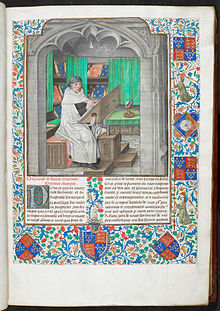speculum literature
Jump to navigation
Jump to search
See also: Speculum literature and speculum-literature
English
[edit]
Alternative forms
[edit]Etymology
[edit]From Latin speculum (“mirror”) in the title of these works.
Noun
[edit]speculum literature or (rare) speculum literature (uncountable)
- A medieval literary genre, popular from the 12th through the 16th centuries, inspired by the urge to encompass encyclopedic knowledge within a single work.
- 1989, Paula Sommers, “Le Miroir: Biblical Ascent”, in Celestial Ladders: Readings in Marguerite de Navarre’s Poetry of Spiritual Ascent, Geneva: Librairie Droz S.A., →ISBN, page 50:
- Mirror or speculum literature, as Jourda and Cottrell have noted, can be traced back through medieval tradition to Augustinian, Biblical and Platonic sources.
- 1990, Rebecca W[eld] Bushnell, “Tyrannical Vices: Morality Plays and Humanist Drama”, in Tragedies of Tyrants: Political Thought and Theater in the English Renaissance, Ithaca, N.Y., London: Cornell University Press, →ISBN, page 80:
- However, insofar as these plays resemble statecraft or speculum literature, they also exhibit the rhetorical instability of statecraft discourse, in which antithesis fails to contain the tyrant. […] In “The Background and Sources of Preston’s Cambises,” English Studies 31 (1950): 129–35, and “The Authorship and Political Meaning of Cambises,” English Studies 36 (1955): 289–99, for example, W. A. Armstrong describes Cambyses as an example of speculum literature, in which the “naiveness” of characterization reflects the rhetoric of statecraft (p. 294).
- 2004, Stephen John Campbell, “Tanta amorosa impresa: Isabella, Perugino and Paride da Ceresara”, in The Cabinet of Eros: Renaissance Mythological Painting and the Studiolo of Isabella d’Este, New Haven, Conn., London: Yale University Press, →ISBN, part II (The Paintings), page 184:
- As Anna Musso has pointed out, the adaptation of the genre to a female dedicatee places the text outside the normal run of speculum literature and identifies it with the rising literature in defence of women, which argued against their inferiority to men.
- 2016, Rory Loughnane, “The Medieval Inheritance”, in Michael Neill, David Schalkwyk, editors, The Oxford Handbook of Shakespearean Tragedy, Oxford, Oxon: Oxford University Press, →ISBN, part I (Genre), page 39:
- The sententious lessons of Lydgate’s great work contributed to the continent-wide development of a sub-genre of speculum literature: ‘advice to princes’.
- 2022, “Introduction”, in An Illustrated Speculum Humanae Salvationis: Green Collection MS 000321, Leiden, Boston, Mass.: Brill, →ISBN, page 1:
- The Speculum humanae salvationis, or ‘Mirror of human salvation’, is an anonymous composition, originally written in Latin, in rhyming verse, sometime between 1309 (as a reference to the Avignon papacy indicates) and 1324 (the date on two copies) as part of the genre of encyclopedic speculum literature.
Further reading
[edit] speculum literature on Wikipedia.Wikipedia
speculum literature on Wikipedia.Wikipedia